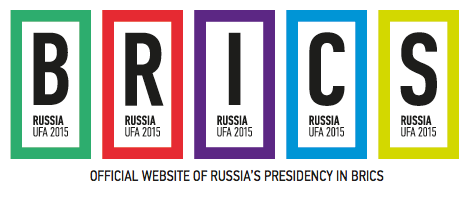At its seventh annual summit, the BRICS group of countries (Brazil, the Russian Federation, India, China and South Africa) announced the BRICS Economic Partnership Strategy through 2020, which aims to strengthen ties in energy, high technology, agriculture, science and education.
The BRICS also adopted the New Development Bank and Contingent Reserve Arrangement, with a total capacity of US$200 billion.
 9 July 2015: At its seventh annual summit, the BRICS group of countries (Brazil, the Russian Federation, India, China and South Africa) announced the BRICS Economic Partnership Strategy through 2020, which aims to strengthen ties in energy, high technology, agriculture, science and education. The BRICS also adopted the New Development Bank and Contingent Reserve Arrangement, with a total capacity of US$200 billion.
9 July 2015: At its seventh annual summit, the BRICS group of countries (Brazil, the Russian Federation, India, China and South Africa) announced the BRICS Economic Partnership Strategy through 2020, which aims to strengthen ties in energy, high technology, agriculture, science and education. The BRICS also adopted the New Development Bank and Contingent Reserve Arrangement, with a total capacity of US$200 billion.
The summit was held on 9 July 2015, in Ufa, the Russian Federation, which currently holds the BRICS presidency. During his closing press conference, Russian President Vladimir Putin said the group had “opened the door to the practical operation of BRICS financial institutions.” The New Development Bank is funded by contributions from each member country, which will be invested in sustainable development and infrastructure projects, starting in early 2016, as outlined in the Ufa Declaration adopted at the summit.
One of the major focuses of the summit was energy and energy efficiency, with countries exchanging information on efficient technologies and urging their businesses to develop such technologies. The Economic Partnership Strategy identifies as priorities, inter alia: promoting universal access to energy; increasing energy efficiency, including joint development and sharing of energy efficient and cleaner energy technologies; introducing environmentally friendly technologies of energy production, storage and consumption; and promoting the use of renewable sources of energy. The document also suggests ways for countries to achieve these goals.
During his remarks, Indian Prime Minister Narendra Modi noted the challenges posed by climate change, saying that the BRICS have “both the expertise and resources to ensure that renewable energy is used more actively and so that we can provide access to renewable energy sources and energy efficiency technology to all.” He expressed the hope that the New Development Bank would finance clean energy projects in all BRICS countries.
Modi also called for closer cooperation among the BRICS countries on adoption of the anticipated Paris climate change agreement in 2015. His call was echoed by the leaders of Brazil, China and South Africa, and in the summit’s Declaration. The Declaration also reiterates the countries’ commitments to agriculture and food security, and the exchange of technology and scientific knowledge in the face of climate change.
The BRICS summit was held in parallel with the Shanghai Cooperation Organization (SCO), which is comprised of China, Kazakhstan, Kyrgyzstan, the Russian Federation, Tajikistan and Uzbekistan. In addition, the summit was preceded by meetings of the BRICS Sherpas and Sous-Sherpas, the Contact Group on Economic and Trade Issues, Ministers of Youth Affairs, the Business Council, Finance Ministers and Central Bank Governors, New Development Bank Board of Governors, Trade Ministers, as well as other forums and working groups. [Ufa-2015 SCO BRICS Office Group Press Release] [Ufa-2015 Website] [BRICS Russian Presidency Website] [BRICS Summit Transcript] [Russian Presidency Closing Press Conference] [Ufa Declaration] [Ufa Action Plan] [BRICS Economic Partnership Strategy]